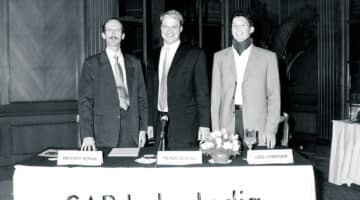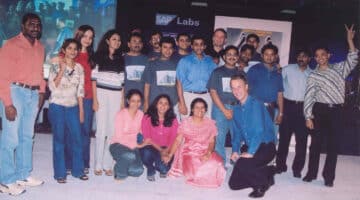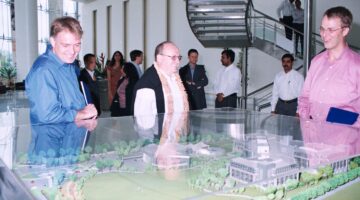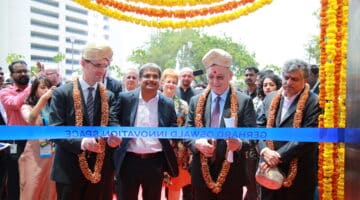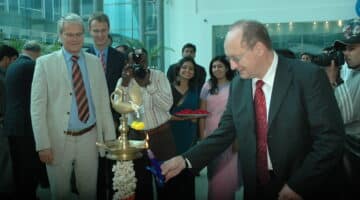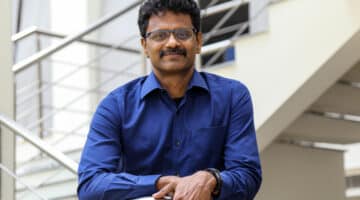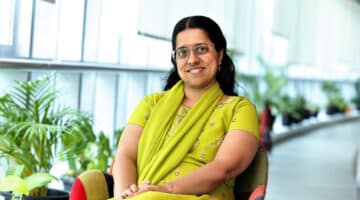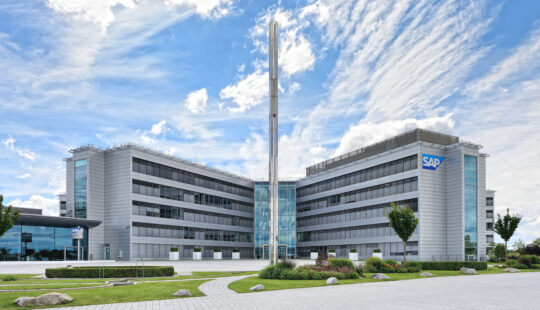As SAP Labs India celebrates its 24th anniversary, we reflect on an exciting journey fueled by vision, entrepreneurial spirit, and a readiness to innovate.
It is early November 1998. Rao Prasada and his colleagues are working up a sweat by heaving servers and 21-inch monitors on the 12th floor of the International Technology Park Limited (ITPL) building in Whitefield, a few miles outside of Bengaluru in southern India.
There is a palpable anxiety and excitement in the office. Prasada and his team are on a tight deadline. As system administrators, it is their responsibility to get the network of computers, monitors, and servers up and running on November 13, when the new campus of SAP Labs India will be inaugurated by senior SAP executives.
“The 100 employees who were moving into the new campus had to go live on the first day,” recalls Prasada, adding that for him and his colleagues, moving into a new office, about 11 miles away from their existing rented premises in Koramangala, was a matter of great pride.
Today, SAP Labs India is a strategic hub within SAP’s global network of development centers, with more than 8,500 employees across five cities: Bengaluru, Gurgaon, Mumbai, Hyderabad, and Pune. Most work at the SAP Labs India campus in Bengaluru, which was inaugurated in 2003, just over a mile from the ITPL building.
Prasada, who now leads a team of IT experts, is still with the company – like many others. They have been part of the exciting and impressive story of SAP Labs India, which is about learning and lateral thinking, about localization and globalization, growth and scaling.
Above all, though, it is a story about innovation. Clas Neumann — now head of the SAP Labs Network — helped shape SAP Labs India as its managing director from 1999 until the beginning of 2005, first jointly with Udo Urbanek and then later with Martin Prinz, then as its president from 2007. Neumann credits SAP with laying the foundations for the development of standard software and much more.
“By not following the trend of just offshoring IT work at the lower end of the value chain, but integrating its Indian development center as one of the four major development hubs, SAP innovated distributed research and development processes,” he says.
Major Strategic Role
SAP Labs India is now the second-largest SAP development location after Walldorf. The teams work on all the major solutions — from SAP S/4HANA and SAP HANA through SAP Business Technology Platform to the entire range of business area products.
As one of four global hubs, along with Germany, China, and the U.S., SAP Labs India is where a great many strands come together. Many successful products and solutions have originated from SAP Labs India, including SAP Asset Intelligence Network, SAP Digital Manufacturing Insights, SAP Connected Worker Safety, and SAP Fashion Management.
Here too sizeable teams work closely with customers across the globe. Bengaluru is also home to an SAP Co-Innovation Lab and SAP’s startup accelerator program, the SAP Startup Studio, which went live in 2016.
SAP Labs India has significant strategic importance but it has had to work hard to earn it.
Toward the end of the 1990s, when the internet hype was at its height, SAP was still enjoying the double-digit growth of the past. But trends like customer relationship and supply chain management — accelerated by successful new companies like Siebel and I2 — brought pressure on several fronts. In order to keep pace and bring the necessary offerings to the market as quickly as possible, SAP had no choice but to bolster its development resources.
Then Co-CEOs Hasso Plattner and Henning Kagermann, along with their SAP Executive Board colleagues, opted for a two-pronged strategy, consisting of acquisitions and the establishment of new SAP Labs in countries where developers were easier to find than they were at the Walldorf, Silicon Valley, and Tokyo locations.
In late 1997, SAP acquired a 50% share in Kiefer & Veittinger GmbH (K&V), a European market leader in sales force automation software, as its route into the evolving customer relationship management (CRM) market. Founded not far from SAP in Mannheim in 1986, the company had operated a development center in Bengaluru with almost 90 employees since 1995. One of them was Rao Prasada.
“The hardware, all of which moved with us, was heavy. But our managing director, Udo Urbanek, lugged his monitor into our new offices himself,” Prasada recalls. He also remembers the Friday parties and K&V’s unofficial company motto: “Work hard, party harder.”
“We continued with those parties, which were very bonding experiences,” says Prasada with a grin. The open company culture after the merger in 1998 also left a lasting impression on him: “Everyone helped everyone else; everyone spoke with everyone else — no matter their status in the hierarchy.”
New SAP Labs: Two Pillars
The acquired K&V employees formed one pillar of the new SAP Labs; the other was a team of experts from SAP India, who localized the SAP software and adapted it to Indian legal requirements.
SAP India had been founded in March 1996 in Bengaluru, with offices in Mumbai and New Delhi and a remit to sell and implement SAP software. They were now joined by the localization team. One of its members was Uma Rani TM. She had already gained SAP software experience working at Tata Consulting Services. She implemented SAP at Hewlett-Packard’s Indian subsidiary, gained certification as a Sales & Distribution (SD) consultant, and soon began training others in ABAP.
“SAP R/3 gained traction very fast in India, and SAP quickly became known on the business scene here. But it was not yet as familiar a name in developer circles,” she says. Together with a small team in Singapore that was asked to adapt the HR and payroll software for India and other Asian countries as well, Uma Rani TM worked in the early days with just three colleagues on the SD, Materials Management (MM), and Financial Accounting (FI) modules for the India country version.
Clearly, though, SAP urgently needed more developers. In December 1997, a decision was made to move the localization team from Singapore to India and merge it with the team that was responsible for the country version there. At the same time, a project initiated by the SAP Executive Board and spearheaded by Neumann, then assistant to SAP Executive Board Member Peter Zencke, and Thomas Vetter, assistant to Kagermann, concluded that Bengaluru was an ideal location for SAP to overcome its shortage of skilled developers quickly.
These factors were the trigger for the foundation of SAP Labs India in November 1998. Its first joint managing directors were Udo Urbanek and Werner Konik, who had led the localization project for Asia. At the opening ceremony for the offices in the ITPL building in Bengaluru, Zencke explained that the location’s focus would be on driving the localization of SAP R/3 for the Asia-Pacific region and developing software for CRM and solutions for the high-tech, oil and gas, aerospace, and defense industries.
Close Cooperation with Walldorf
From day one, the development teams in Bengaluru worked closely with their colleagues in Germany and at other locations. According to Martin Prinz, who took over responsibility for the India country version from Konik, his team in India proved that there was an alternative to the traditional approach of centralized development, and that it was feasible to cooperate with co-developers in other locations. “In our case, it worked because we were so closely connected with the core development team in Germany and we did have a lot of support from there,” Prinz says Martin.
“It was an interesting journey,” says Uma Rani TM, who reported to Prinz at the time. “From a development point of view, it was tough, but so interesting to learn. Martin and the managing directors made a real effort to be there for us at all times.”
Yet, with the best will in the world, both sides needed time to get used to each other. “It often happened that people suddenly switched to speaking German in meetings,” says Uma Rani TM. “We had to remind them that we were there.”
Prasada remembers Urbanek attaching “great importance to punctuality, both at meetings and in completing tasks.” A characteristic that Prasada took home with him – and that did not always go down well with his family. He also learned fast that Germans tend to be quite direct. “But, if I had a problem and needed help, I always received support right away.”
Business trips to each other’s home countries helped foster mutual understanding and gave everyone a chance to broaden their horizons — culinary and otherwise. “Getting a vegetarian meal at the cafeteria in Walldorf and finding a restaurant in Walldorf or Heidelberg that served meat-free dishes was quite a challenge back then,” says Uma Rani TM with a grin. “But we found our ways.”
English gradually became the company language. For the first time, SAP invested into intercultural training for Germans and Indians followed by offerings for other nations. “This way, the establishment of SAP Labs India contributed decisively to SAP’s globalization,” says Neumann.
By 2001, there were already more than 500 SAP employees in Bengaluru.
Sharp Increase in Headcount
Although headcount growth in Bengaluru slowed when the dot-com bubble burst, it returned to its steep upward path from 2003 onward. SAP Labs India opened its new campus in Whitefield in November 2003. Prinz, who now co-managed the location with Neumann, described their role at the time as follows: “SAP Labs India is a place for SAP to scale for the future. We have to demonstrate that we can grow fast while remaining stable and reliable.”
By the end of 2004, the workforce had reached 1,350, and every line of business was represented in India. Georg Kniese, today global head for Corporate Development and M&A, became joint managing director with Prinz at the beginning of 2005. The locations invested heavily in employee training and bolstered their development and support unit resources. The aim was to create a global hub of SAP knowledge.
“We wanted to be part of the global development process, be close to our customers, continue driving localization, develop customer-specific solutions, and be on the spot when escalations happened,” recalls Kniese. By the end of 2005, SAP Labs India’s payroll numbered almost 2,300.
Two years later, that figure had risen by another 1,000, and SAP Labs India became the second-largest development location outside Walldorf. When Kniese returned to Germany at the end of 2007, SAP Labs India got its very first Indian managing director: Kush Desai. His counterpart in Gurgaon was Ferose V.R. And in another first, teams in Bengaluru took on full global responsibility for a product: SAP Employee Self-Service.
“As far as I can tell, we were the first company to develop a solution from demand analysis to final product and maintenance in Bengaluru,” says Neumann. “Many companies and academia visited us at the labs now to learn what it takes to implement a research and development function globally. Thereby we certainly had an impact on the Indian IT sector.”
Uma Rani TM remembers this period of rapid growth very clearly. In her view, it happened because SAP needed developers and looked to India, where they were affordable. “The benefit for our employees was that this growth created lots of new opportunities for them to progress professionally.”
After five years on the localization team and having completed an MBA, Uma Rani TM herself took the opportunity to take charge of the Installed Base Maintenance & Support (IMS) team in Bengaluru in 2003. “My managers always supported and encouraged me greatly,” she says. Now in her 25th year at SAP, Uma Rani TM is head of Application Innovation Services.
Indian Customers Benefit from Proximity to SAP Labs
In 2007, India was SAP’s fastest-growing market. Revenues doubled that year, and continued to do so in the years that followed. According to Neumann, SAP Labs were the engine for this success. The sales personnel in India benefited enormously from being close to developers.
“Very often, meetings in Bengaluru were the key to getting deals signed,” says Neumann. “The labs made it clear to customers from the get-go that SAP was here to stay and that it had the required expertise available locally.”
Uma Rani TM adds that “having such a great campus with great experts in this location has really helped our customers and the business be closer to our developers. This enabled us to drive the transformation with deep product and business expertise.”
In April 2010, Ferose V.R. became sole managing director of SAP Labs India. He encouraged the workforce, now numbering over 4,000, to experiment with new ideas and to find creative solutions to some of their problems, such as a lack of childcare and the tedious process of claiming for travel expenses. He founded an SAP AppHaus location on the Bengaluru campus, where designers, developers, and marketeers could collaborate on innovative solutions. He also initiated several interest groups for employees, including a book club, “to create a unique environment for employees and a culture of innovation.”
And in 2011 he started to hire people with autism. Ferose V.R. worked with some of the most influential thinkers on autism studies to learn from best practices and further grow and improve the program, which then became SAP’s Autism at Work program. Since then, the program has grown rapidly and expanded globally.
Putting Faith in Employees’ Creative Powers
Dilip Khandelwal became managing director of SAP Labs India in August 2014. In Bengaluru, more than 2,500 employees work in the Gerhard Oswald Innovation Space, a contemporary, €50 million building that was opened in April 2017 in honor of SAP’s long-serving Executive Board member and supporter of SAP Labs.
Fostering Startups
One of Khandelwal’s central elements of his strategy was initiating the SAP Startup Studio. Here, SAP Labs locations offer startups consulting, support, infrastructure, and technology for one year to get their enterprise off the ground. Working out of chic facilities on the SAP Labs India campus, participants can benefit from support from SAP employees to help them bring their idea to market and expand their business successfully. Moreover, the startups can profit from making contact with SAP customers and partners. SAP works with the startups to complement its own offerings, too.
Khandelwal’s successor is Sindhu Gangadharan, about 20 years after she started as a developer at SAP Labs India. She works day in, day out to extend and reinforce SAP Labs India’s standing in the global SAP Labs Network and within the country’s IT sector.
Just like Sindhu Gangadharan and Ferose V.R., Rao Prasada is still with SAP — he too wants to continue playing his part in SAP Labs India’s success story.
This article is based in part on the book by Clas Neumann and Jayaram Srinivasan entitled “Managing Innovation from the Land of Ideas and Talent” and published by Springer.

